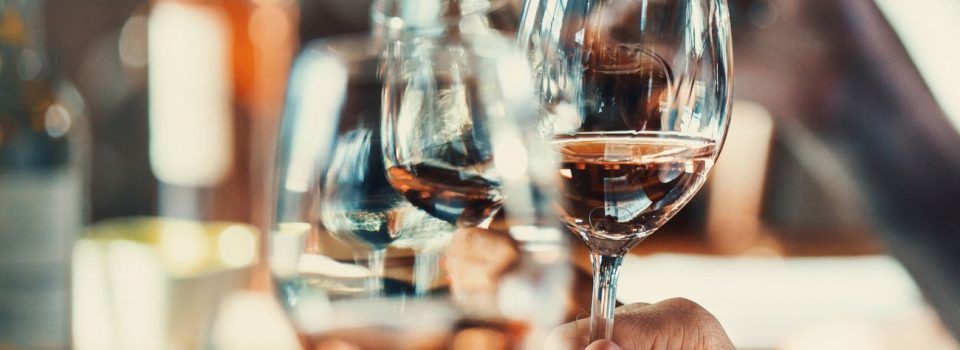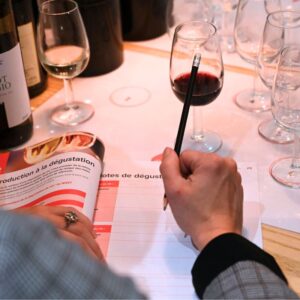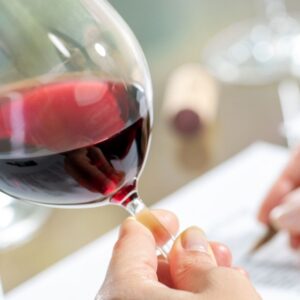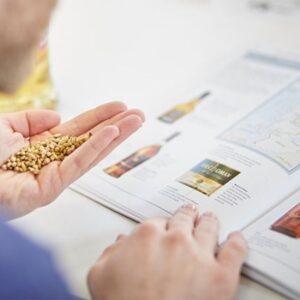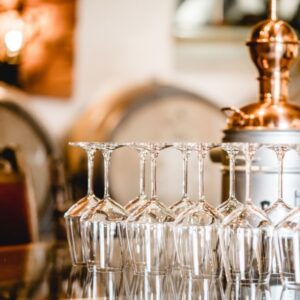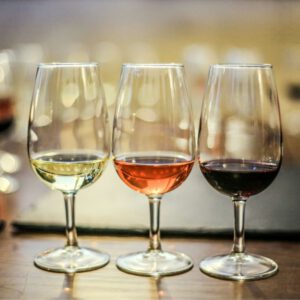Deciding to host a wine tasting at home might seem intimidating at first, but in reality, it’s an exciting and accessible experience, even for beginners.
Whether you’re a curious wine enthusiast or a seasoned connoisseur seeking new discoveries, deciding to host a wine tasting is the perfect opportunity to refine your palate and explore a wide range of flavors and aromas. Not only does it provide a fun activity with friends, but it’s also a fantastic way to deeply understand the art of wine tasting and appreciate the richness of wine.
In this article, we’ll guide you through each step of organizing a successful wine tasting, offering practical tips and expert advice. Whether you’re looking for specific wines to taste, methods to structure your event, or recommendations on food and wine pairings, we’ve got everything you need to turn this activity into a memorable experience.
Moreover, as specialists in wine, spirits, sake, and beer training, and WSET-certified, we’ll share our expertise and best practices for hosting a professional wine tasting at home. If you want to go further and perfect your tasting skills, our courses are the next step to becoming a true expert in the world of wine.
Let’s get started and discover how to organize an unforgettable wine tasting at home!
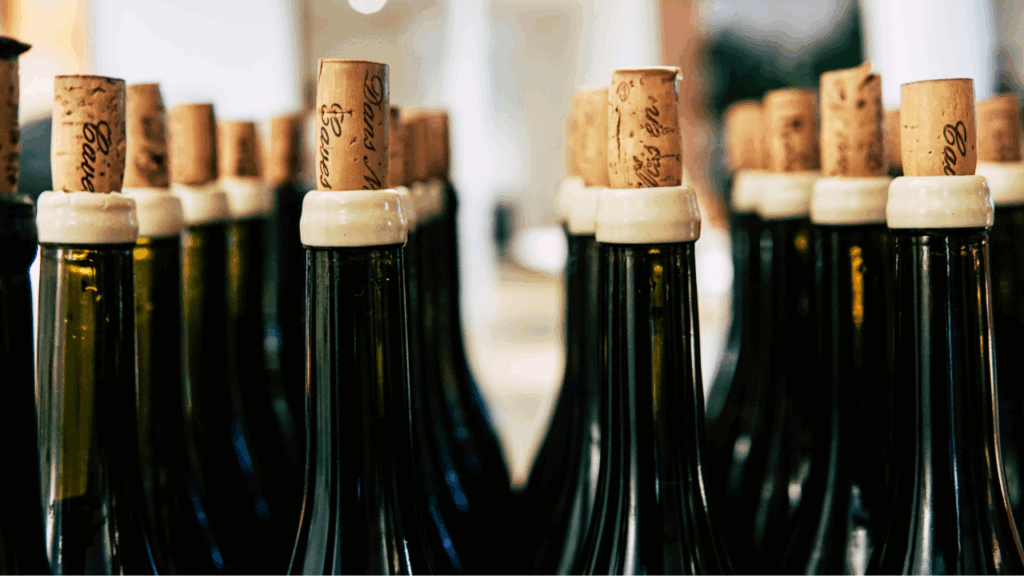
1. Choose the theme of your wine tasting
Choosing a theme is one of the most important steps when you decide to host a wine tasting successfully. A well-defined theme will give direction to your event, facilitate wine selection, and guide your guests through a coherent and enriching experience.
Here are some popular and original theme ideas to spice up your at-home tastings:
Wine tasting by wine region: explore the terroirs
One of the simplest ways to structure a tasting is by choosing a specific wine region.
Each region offers a palette of wines with unique characteristics influenced by climate, terroir, and local winemaking techniques.
This type of tasting allows your guests to discover the diversity of wines from the same geographical area.
Here are some ideas:
- Bordeaux: Dive into the great wines of Bordeaux, tasting classic reds like Cabernet Sauvignon from Saint-Julien or Merlot from Saint-Émilion, along with dry whites made from Sauvignon Blanc from Pessac-Léognan.
- Rhône Valley: Explore the complexity of wines from this region with powerful Grenache from Châteauneuf-du-Pape and spicy Syrah from Côte-Rôtie, or fresh whites made from Viognier.
- Tuscany: Offer a sensory journey through Sangiovese from Chianti or Brunello di Montalcino, along with Super Tuscans, tasting a variety of reds and whites.
Vertical tasting: a journey through time with different vintages
A vertical tasting involves tasting several vintages of the same wine or the same winery. This method allows you to discover how a wine evolves over the years and observe how its aromas, structure, and complexity change with time.
This can be particularly interesting with wines meant to age, such as great Bordeaux or Burgundy wines.
Example: Taste several vintages of Château Margaux or Clos Vougeot to understand how aging influences their taste and texture.
Tasting by grape variety: discover the great grape varieties
Choosing a grape variety as a theme allows you to explore different expressions of the same grape, depending on terroirs and winemaking techniques.
This offers an interesting perspective and allows you to compare different aromatic profiles.
For example, if you choose Pinot Noir, you can taste wines from Burgundy, California, Oregon, or even Australia, noticing the differences in flavor and texture.
Grape varieties to explore: Pinot Noir, Sauvignon Blanc (Sancerre, Napa Valley, Marlborough), Chardonnay (Burgundy, Santa Barbara County, Casablanca Valley in Chile, Walker Bay in South Africa, Mornington Peninsula in Australia), Merlot (Bordeaux, Sonoma County, Chile), Syrah (Rhône, Paso Robles, Argentina, Barossa Valley in Australia).

Tasting organic, biodynamic, and natural wines: an ethical and original exploration
Organic and natural wines are on the rise, attracting more consumers who are environmentally conscious. A tasting dedicated to these wines allows you to discover products that respect nature, often made with less interventionist winemaking techniques.
You can explore wines that are neither filtered nor sulfured, offering more authentic and sometimes bolder flavor profiles. Pay attention to potential defects in wines without added sulfites (such as Brettanomyces, mousey flavors, or oxidation).
Example: Taste organic wines from small producers or explore natural wines, which often present more complex and varied aromas.
Original themed tasting: the possibilities are endless
You can also organize a more creative tasting by choosing out-of-the-ordinary themes.
For example, you might explore orange wines, made by fermenting white grape skins with the juice. Or, you could have a tasting highlighting wines from lesser-known countries, such as Lebanon, Greece, or South Africa. This type of theme will surprise your guests while broadening their wine horizons.
Examples: Orange wine tasting, Lebanese wines, South African wines, or rare Chilean wines.
Choosing a theme for your wine tasting at home is not only about enjoyment, but also a way to structure the experience and offer your guests an enriching sensory exploration.
Whether you opt for a classic regional tasting, a vertical tasting to explore the evolution of vintages, or a discovery of organic and natural wines, each theme adds a unique dimension to your event.
By combining your basic knowledge with expert advice, you’ll create a memorable evening that will delight your guests and help you develop your tasting skills.
If you want to go further and deepen your wine knowledge for hosting a wine tasting, our WSET courses are an excellent way to master the art of tasting and earn internationally recognized certification.

2. Selecting the wines for the tasting
Once you’ve chosen the theme for your tasting, the next step is to select the wines. This step is crucial for ensuring a harmonious and engaging experience.
Choosing the right wines not only helps create coherence between different aromatic profiles, but also surprises and delights your guests. Here are some tips for making the right choices, no matter the theme of your tasting.
1. Combine complementary and contrasting wines
The goal of a wine tasting is to stimulate your guests’ palates by offering a variety of flavors and aromas. It’s essential to select wines that complement each other while providing interesting contrasts.
For example, if you’re organizing a red wine tasting, start with a light and fruity wine, then move on to a more structured and tannic wine.
For a white wine tasting, vary the styles by choosing a dry wine, followed by a rounder wine or even a sweet one.
- Example: For a red wine tasting, start with a Pinot Noir (light) and move to a Cabernet Sauvignon (full-bodied).
- Example: For a white wine tasting, begin with a fresh Sauvignon Blanc, then move to a round, oaky Chardonnay.
2. The number of wines: ideal between 3 and 5 wines
To avoid overwhelming your guests and to allow for a more detailed appreciation of each wine, it’s recommended to select between 3 and 5 wines for your tasting. This allows you to taste a variety of wines without losing focus or compromising the quality of the experience.
Generally, choose a small selection that allows you to explore the nuances of each wine thoroughly.
- Example: For a regional tasting, select 3 to 4 representative wines from the region, varying the styles (a light red, a tannic red, a dry white, etc.).
- Example: For a grape variety tasting, 3 to 5 wines from different producers will help you compare variations of the same grape.
3. Choose wines based on serving temperature
Serving temperature is a crucial element that greatly influences the tasting experience. To allow each wine to fully express its potential, it’s important to serve it at the optimal temperature.
As a general rule:
- Red wines: Serve slightly chilled (between 14°C and 18°C), except for highly tannic wines or fine wines, which can be served at room temperature.
- White wines: Serve chilled (between 8°C and 12°C), except for more complex whites (like Chardonnay), which can be served slightly warmer.
- Rosé wines: Serve between 8°C and 10°C to preserve their freshness.
- Sweet wines: Serve chilled or slightly refrigerated, depending on the style.
If you choose to serve wines at a lower temperature, don’t forget to take them out earlier to allow them to breathe before tasting.
4. Select quality wines: look for recognized labels
It’s essential to select high-quality wines to ensure a successful tasting. Quality wines are produced with care, often from renowned wineries or well-established domains.
If you really want to impress your guests, opt for wines from well-known producers in the wine region you’re exploring.
- Example of renowned producers: If you’re exploring Bordeaux, look for wines from Château du Tertre or Château Siran. If you choose Burgundy, go for domaines like Domaine Faiveley or Domaine de la Vougeraie.

Pro Tip: If you’re unsure about the quality of the wines, ask your wine merchant for guidance or opt for award-winning or certified domains.
5. Consider both young and aged wines
One of the recurring questions when organizing a wine tasting is whether to choose young wines or aged wines. Young wines have fresh and fruity aromas, while aged wines offer more complex profiles that evolve over time.
For an interesting tasting, it’s often recommended to combine both.
Example: Taste a young wine to discover its primary aromas (such as a fresh Pinot Noir), then taste an older wine to appreciate the evolution of its aromas (like an aged Cabernet Sauvignon).
The selection of wines is a key step in organizing your wine tasting at home. By choosing complementary wines, considering the serving temperature, and prioritizing quality wines, you ensure a pleasant and memorable tasting experience. Be sure to vary the styles and grape varieties to offer your guests a broad spectrum of flavors that will awaken their senses.
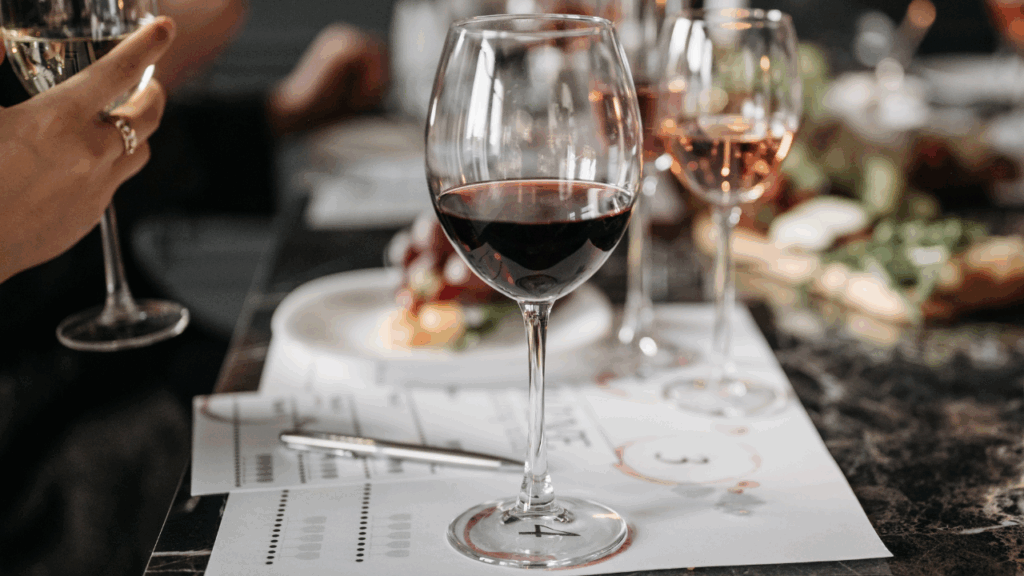
3. Prepare the necessary equipment
Organizing a wine tasting at home requires careful preparation, not just for the wines themselves, but also for the equipment you’ll be using. Having the right tools at hand ensures an optimal experience that is both practical and enjoyable.
Here’s a list of essential equipment to guarantee a successful tasting:
Wine glasses
Choosing the right glasses is essential to fully appreciate the aromas and texture of the wine. Each type of wine benefits from a specific glass designed to highlight its characteristics:
- Red wine glasses: Choose glasses with a large bowl to allow the wine to breathe and release its aromas. Red wines require more space to develop.
- White wine glasses: White wine glasses have a narrower bowl to concentrate the aromas and preserve the wine’s freshness. They should be smaller than red wine glasses.
- Champagne glasses: Opt for flutes or tulip-shaped glasses to better preserve the bubbles and concentrate the aromas.
- Universal wine glasses: If you don’t have specific glasses for each type of wine, universal wine glasses can work well for a wide range of wines.
Decanters and ice buckets
Some wines, especially young reds or whites that need slight chilling, benefit from decanting. This helps the wine breathe, releasing aromas and softening tannins.
For white or rosé wines, an ice bucket is also recommended to keep them at the right temperature during the tasting.
- Decanter: Ideal for aerating young wines or separating wine from sediment in older wines.
- Ice bucket: Keeps white or rosé wines at the optimal cool temperature (8-12°C). An ice bucket is also useful for sparkling wines like Champagne or Prosecco.
Napkins or tablecloths
The cleanliness of your equipment is crucial for ensuring a quality tasting.
Clean napkins or a tablecloth not only protect your table from spills but also add an elegant touch to the event.
If you’re serving multiple wines, napkins or drop-stops are useful to wipe up drips and avoid interference between the wines.

Chalk or markers for notes
It’s important to take notes on the characteristics of each wine during a tasting. For this, use chalk or markers to write information on the bottle labels or on tasting cards.
These notes will help you remember the wines you’ve tasted and compare the profiles of each wine.
- Tasting cards: Use pre-filled tasting cards with winemaking, aroma, and flavor criteria, or create your own. This is a great way to guide discussion during the tasting.
- Sheets and pens: Sheets of paper or a notebook can be useful for writing more detailed, personal impressions.
- Aroma sheets: You can also download WSET’s SAT (Systematic Approach to Tasting) sheets to help your guests identify the aromas and flavors they perceive in the wines.
Thermometer to check the wine’s temperature
A thermometer is a simple yet very useful tool to ensure each wine is served at the ideal temperature.
Wines should be served at specific temperatures to reveal their full complexity. For example, light red wines should be slightly chilled, while white wines should be served well chilled.
Wine thermometer: A wine thermometer is easy to use and will help you adjust the serving temperature, ensuring an optimal tasting experience.
Containers for leftover wine
During the tasting, it’s common for guests not to finish every glass of wine. Having containers to store leftover wine is a good idea.
You can use decanters or small bottles to preserve the wines and protect them from the air, allowing you to continue the tasting later or share them with your guests at another time.
A successful wine tasting relies not only on the quality of the wines but also on the equipment you use. By having the right glasses, a decanter or ice bucket, napkins, a thermometer, and tools for taking notes, you ensure a smooth and professional experience.
A little preparation of the necessary equipment will allow your guests to focus on what matters most: appreciating the wines and exchanging thoughts on their aromas and flavors.
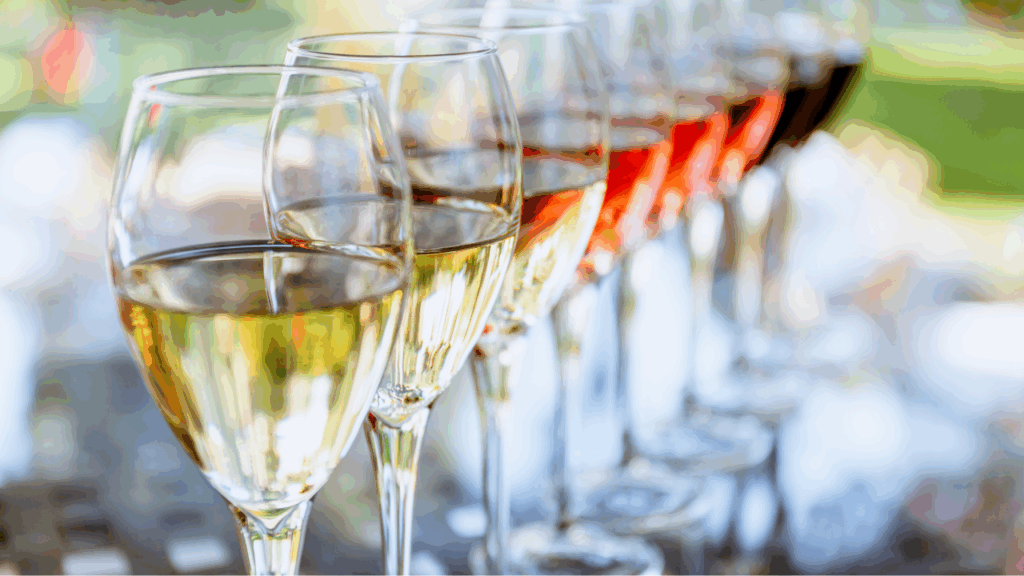
In Part 2 of this article…
Discover how to organize and structure your at-home wine tasting experience, how to elevate the flavors with perfect food and wine pairings, and how to make a difference so your guests have an unforgettable evening!
Click here to read Part 2 and learn how to host a wine tasting at home!
If you want to take your wine tasting skills to the next level and gain in-depth knowledge about wines, our WSET courses offer a great opportunity to become an expert and enhance your expertise.
We also offer oenology courses in Marseille and private classes upon request – perfect for your hen or bachelor parties, gatherings with friends, or corporate events. Join us in our Marseille location or in your own venue.
